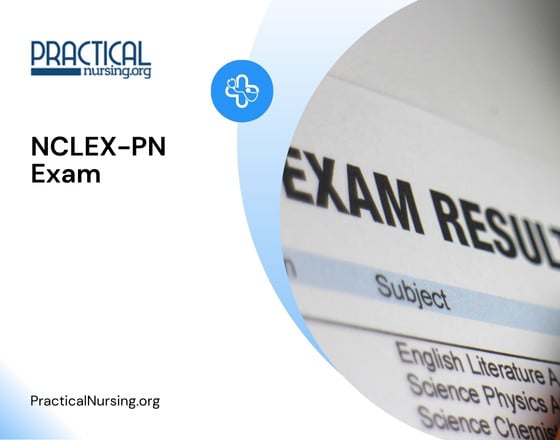NCLEX-PN Exam


What Is the NCLEX?
Are you looking for a FREE NCLEX-PN Exam Practice Test? We have a 150-question practice exam with rationales for you.
NCLEX stands for National Council Licensure Examination. This is usually followed by two other letters; either PN or RN. These refer to whether the exam is for Practical Nurse or Registered Nurse. The NCLEX is a test that is administered to all nursing school graduates.

It is meant to ensure that each nurse is competent and can practice safely as a new nurse. The NCLEX is based on Computerized Adaptive Testing (discussed further here). CAT basically means that each test is different. Each candidate receives an individualized and unique testing experience. The NCLEX exams are produced by the National Council of State Boards of Nursing (NCSBN). Each year, the NCSBN surveys newly licensed nurses in order to update and ensure relevancy for the NCLEX. This ensures that the test matches what nurses are doing in their field.
The NCSBN was founded in 1978 as a non-profit and independent organization. The organization states that it was formed “to guard the safety of the public” and under the premise that “the regulation of nurses needed to be a separate entity from the organization representing professional nurses.”

2024 NCLEX-PN Pass Rates
| Type of Candidate | Jan. – March | April – June | July – Sept. | Oct. – Dec. | Total (2024) | ||||||||||
|---|---|---|---|---|---|---|---|---|---|---|---|---|---|---|---|
| # Testing | # Passing | % Passing | # Testing | # Passing | % Passing | # Testing | # Passing | % Passing | # Testing | # Passing | % Passing | # Testing | # Passing | % Passing | |
| First-time, U.S.-educated |
|||||||||||||||
| RN Diploma | 578 | 544 | 94.1% | 867 | 805 | 92.8% | 693 | 614 | 88.6% | 286 | 239 | 83.6% | 2,424 | 2,202 | 90.8% |
| RN Baccalaureate | 26,897 | 25,450 | 94.6% | 34,448 | 32,215 | 93.5% | 28,428 | 25,654 | 90.2% | 9,431 | 7,876 | 83.5% | 99,204 | 91,195 | 91.9% |
| RN Associate Degree |
24,313 | 22,851 | 94.0% | 31,017 | 28,550 | 92.0% | 21,405 | 18,859 | 88.1% | 7,845 | 6,395 | 81.5% | 84,580 | 76,655 | 90.6% |
| Special Program Codes |
154 | 59 | 38.3% | 132 | 51 | 38.6% | 128 | 53 | 41.4% | 138 | 41 | 29.7% | 552 | 204 | 37.0% |
| Total First-time, U.S.-educated |
51,942 | 48,904 | 94.2% | 66,464 | 61,621 | 92.7% | 50,654 | 45,180 | 89.2% | 17,700 | 14,551 | 82.2% | 186,760 | 170,256 | 91.2% |
| Repeat, U.S.-educated |
6,606 | 3,487 | 52.8% | 6,876 | 2,962 | 43.1% | 9,757 | 5,578 | 57.2% | 8,791 | 4,286 | 48.8% | 32,030 | 16,313 | 50.9% |
| First-time, Internationally Educated |
13,988 | 8,225 | 58.8% | 15,001 | 8,119 | 54.1% | 14,656 | 7,990 | 54.5% | 15,350 | 7,428 | 48.4% | 58,995 | 31,762 | 53.8% |
| Repeat, Internationally Educated |
9,329 | 4,129 | 44.3% | 9,967 | 3,732 | 37.4% | 9,741 | 3,504 | 36.0% | 11,045 | 3,212 | 29.1% | 40,082 | 14,577 | 36.4% |
| All Candidates | 81,865 | 64,745 | 79.1% | 98,308 | 76,434 | 77.7% | 84,808 | 62,252 | 73.4% | 52,886 | 29,477 | 55.7% | 317,867 | 232,908 | 73.3% |
Past Years NCLEX-PN Pass Rates (First-Time, US-Educated)
- 2022 – 47,635 Takers, 79.93% Pass
- 2021 – 46,356 Takers, 79.60% Pass
- 2020 – 45,661 Takers, 83.08% Pass
- 2019 – 48,234 Takers, 85.63% Pass
- 2018 – 47,031 Takers, 85.91% Pass
Please note: The above numbers reflect first-time test taker pass rates.
What Type of Information Is on the NCLEX-PN?
NCLEX test questions are tricky; the NCLEX is not your average test. Because nurses must be knowledgeable and safe to practice, the NCSBN focuses on high-level thinking. Instead of rote memorization or fill-in-the-blank answers, the test is based on application and analysis questions. These questions require a strong foundational knowledge and understanding of what is being asked. This, combined with critical thinking skills and decision-making ability, demonstrates an understanding of the knowledge needed to practice as a nurse.
The content for the NCLEX-PN falls into four main categories with several smaller subcategories. All test content is based on client needs. Nurses must use their knowledge of medical procedures, assessments, and more to care for the client in the best way possible. Questions from various categories are spread randomly throughout the exam; it does not proceed section by section.
- Safe Effective Care Environment
- Management of care
- Safety and infection control
- Health promotion and maintenance
- Psychosocial integrity
- Physiological integrity
- Basic care and comfort
- Pharmacological and parenteral therapies
- Reduction of risk potential
- Physiological adaptation
Safe and Effective Care Environment
This category makes up about 21-33% of the total NCLEX questions. Most questions in this category are about patient care safety issues. It focuses on the safety of medication administration to patients, measures to prevent injuries and infections, and specific safety topics like isolation procedures, pediatric patients, or mental health/psychiatric patients. Other things that can be included in this category include ethical and legal issues, nursing management, laboratory tests and results, and more. This category covers a wide range of topics.
Health Promotion and Maintenance
This category comprises about 12% of the total NCLEX questions administered. Much of this content is about preventative and proactive measures. Pregnancy and birth are big topics, including infant growth and development, STIs, and proper diet. Maternity classes and human growth and development classes are normally part of each practical nursing program’s educational plan.
Psychosocial Integrity
Psychosocial integrity questions make up about 12% of questions as well. Topics in this category include psychiatric health and diseases, coping mechanisms, crisis intervention, substance abuse, and therapy. Specific diseases vary but can include depression, schizophrenia, organic mental disorders, eating disorders, personality disorders, and anxiety disorders. Students should be familiar with the diagnosis, symptoms, and treatment of mental health disorders. Also, nurses must be aware of their responsibility in the therapeutic process and know how to help patients in these situations.
Physiological Integrity
The bulk of NCLEX are the physiological integrity questions. This group of questions is by far the largest percentage of NCLEX questions, 43-67%. This is partially due to the wide range of topics covered under the umbrella term of physiological integrity. These types of questions deal with the bulk of information learned and applied by practical nursing students. Topics for this section include:
- Adult medical and surgical care: adult care, medical and surgical conditions, assessment, treatment, nursing care, and more
- Pediatric care: growth and development, birth abnormalities, child abuse, infectious diseases common in children, and common childhood injuries
- Gerontology: elderly care, the aging process, medications common in the elderly
- Infectious diseases: general knowledge, chain of infection, etc.
This information is usually taught in medical-surgical nursing, pediatrics, gerontology, pharmacology, and other related fields, depending on each practical nursing program.
Please keep in mind the above information pertains to the NCLEX-PN examination. The NCLEX-RN examination is a separate test. Although some topics and concepts are the same, the tests are meant to evaluate different types of knowledge and problem-solving methods. Because many Practical Nurses continue their education to become Registered Nurses, many take both tests.
The RN licensure examination divides its content into seven categories: safe and effective care/environment management of care (17-23%), safety and infection control (9-15%), health promotion and maintenance (6-12%), psychosocial integrity (6-12%), physiological integrity/basic care and comfort (6-12%), pharmacological and parenteral therapies/reduction of risk potential (9-15%), and physiological adaptation (11-17%).
NCLEX-PN Essentials and NCLEX-PN by the Numbers (According to NCBSN)
- Number of questions: NCLEX-PN contains between 85 and 205 questions
- Average number of questions: 112
- Percent of test takers that receive the minimum number of questions: 57.2%
- Percent of test takers that receive the maximum number of questions: 13.5%
- Minimum test-taking time: none
- Average testing time per candidate: 2 hours and 14 minutes
- Maximum time allowed for NCLEX-PN examination: 5 hours
- Percent of candidates who use the maximum time allowed: 1.1%
- Cost of the NCLEX-PN: $200 (may be higher depending on State Board of Nursing fees)
- How to pay for NCLEX-PN: credit card, debit card, or prepaid card. (no cash or check)

NCLEX Questions and Computerized Adaptive Testing (CAT)
Ask a current licensed nurse about their NCLEX test-taking experience; many will tell you it was not necessarily the content that was confusing or hard to navigate but the NCLEX-style questions. NCLEX testing is different from most testing and there are many question styles that may be included.
The key to succeeding is understanding the NCLEX examination and scoring process and practicing these.
The majority of NCLEX questions administered are multiple-choice type questions. These questions can have any number of answers, from 2-8. For some questions, there is only one correct answer. This is where it gets tricky: some multiple-choice questions are called “multiple-multiple” questions – multiple choices and multiple responses. In other words, there may be more than one correct answer. Some questions will allow the selection of more than one answer. Some questions will have more than one correct answer and require the candidate to choose the “most correct” answer.
There are several alternative question types that can be included on the NCLEX: fill-in-the-blank, hot spot questions, sound questions, chart/exhibit questions, and drag-and-drop questions. Fill-in-the-blank questions are uncommon, but they exist on the NCLEX. Hot spot questions show the candidate a picture or diagram of a patient and require analysis of presented information and decision-making ability by the candidate. Sound questions may present the candidate with heart, lung, or other body sounds and require assessing and applying normal and abnormal body systems. Many multiple-choice and alternate question types are preceded by a small paragraph or scenario.
Check out our FREE NCLEX-PN Practice Test. 150 exam questions with rationales.
Computerized Adaptive Testing (CAT)
The NCLEX-PN uses CAT to test candidates effectively and fairly. NCSBN states, “CAT is a method for administering exams that merges computer technology with modern measurement theory to increase the efficiency of the exam process.”
CAT has several advantages over traditional test administration and scoring methods:
- Gives a reliable and accurate measurement of nursing competency
- Reduces the number of “too easy” and “too hard” questions, which can change results for the worse
- Reduced exposure to certain items, therefore lowering security risks
Below are several definitions provided by the NCSBN about CAT. These can enhance understanding of the CAT process. Candidate ability is defined as the level of entry-level nursing knowledge, skills, and abilities that the candidate has. Ability estimate is the level of entry-level nursing knowledge, skills, and abilities the computer has determined that the candidate has. Passing standard is a cut point along an ability range that marks the minimum ability level requirement. For the NCLEX, it is the minimum ability required to safely and effectively practice nursing at the entry level. Logit is a unit of measurement to report relative differences between candidate ability estimates and item difficulties. CAT has been used since 1994 for the NCLEX examination.
CAT works by dividing questions and assigning them a difficulty level. When a question is answered, the computer re-estimates the candidate’s ability based on previous questions, difficulty levels, and correct/incorrect answers. The computer then offers a question that the candidate should have a 50% chance of answering correctly. After each question and answer, the computer model recalculates these figures in order to provide a correct assessment of knowledge; the more questions that are answered, the more precise computer estimates become. Basically, if a question is answered correctly, the computer records this and selects a harder question for the candidate; if the answer is incorrect, an easier question is provided. This continues until a pass/fail decision can be made.
CAT has three rules for scoring candidates and determining pass or fail. The computer’s decision is made and then checked for quality and correctness. The three pass/fail rules are as follows:
- The first and most commonly used rule for determining pass or fail status is “the 95% confidence interval rule.” This rule uses the predetermined “passing standard.” Once the computer system is 95% confident that a candidate’s ability is clearly above or below the passing standard, a decision is made. The more right answers chosen, the faster a pass decision can be made; the same is true for incorrect answers and a fail decision.
- Next is the “maximum-length exam rule.” This rule takes over when a candidate’s ability is very close to the passing standard. If the maximum number of questions is reached, the computer does not regard the 95% confidence rule. The new rule states that a pass or fail decision is made by the final ability estimate. If this is above the passing standard, a pass is granted; otherwise, the student fails.
- The last rule the computers use to determine scoring is called the Run-Out-of-Time Rule or ROOT Rule. As the name suggests, this rule takes effect when a candidate runs out of time for the examination but has not reached the maximum number of questions. This means that the computer cannot determine with 95% confidence a pass or fail decision. This rule has several scenarios:
- If the minimum number of questions has not been answered, a fail is given
- If the minimum number of questions or higher has been answered, the computer uses the last 60 questions to be answered.
i. If the last 60 ability estimates were above the passing standard, the student passes
ii. If the ability estimate drops below the passing standard, even just once during the last 60 items, a fail is given
Getting Familiar with Pearson VUE
Pearson VUE is part of the Pearson Company, which is touted as the world’s foremost learning company. Pearson VUE offers services such as test development and management and delivering and administering various licensing and certification exams. Pearson VUE provides nursing licensure and examination. They are involved in the process mostly by handling registration for test taking and administering tests in their state-of-the-art technological facilities. There are Pearson VUE testing centers located throughout the country and beyond. Pearson VUE boasts the biggest network of testing centers in the world.
Registration Process through Pearson VUE
Pearson VUE is the only administrator for the NCLEX examinations, and they are offered as computerized tests only. The basic registration process outlined by Pearson VUE is as follows:
- Submit an application for licensure to the appropriate Board of Nursing
- Candidates must meet all Board of Nursing eligibility requirements
- Register for the NCLEX with Pearson VUE. You can register either online or over the telephone. Online registration is faster and easier than telephone registration.
- Receive NCLEX registration acknowledgement email from Pearson VUE
- Candidate is made eligible to test in the Pearson VUE system by the Board of Nursing
- Receive Authorization to Test form (ATT) via email through Pearson VUE
- ATT is valid and able to be used for up to 90 days, if not used within this time it must be obtained again. (Depending on specific Board of Nursing rules, ATT can be valid from between 60 and 365 days. Most are valid for 90 days.)
- Schedule a specific examination location and time with Pearson VUE
NCLEX-PN Exam Day
Before arrival at the testing center, be sure to gather proper identification, testing will not be allowed without it. Pearson VUE recommends dressing comfortably; hats, gloves, scarves, and coats are not allowed in the testing room, however. Keep this in mind when preparing for testing. There are lockers available at Pearson VUE testing centers. Arriving early is always a good idea. 30 minutes before the start of your test is a good time to arrive.

If you are more than 30 minutes late for your test, you will have to forfeit the test and any fees you may have paid.
Upon arrival the Pearson VUE employees will verify identity and other details for testing. Security measures are advanced to enter test-taking areas. Each candidate is required to have a photograph taken, provide a signature, and provide a palm vein scan. Palm vein scans are extremely accurate for identifying individuals, much more so than fingerprint scans. Security measures inside test-taking centers are high as well. Each site uses audio and video recording to monitor all test takers. This is to ensure fair and honest testing, increase the security of testers, and prevent cheating. Outside materials, including paper and writing utensils, are normally not allowed in test-taking rooms. Each test taker is provided with an on-screen calculator on the computer and a dry-erase board and marker.
On exam day, one important thing to remember is to set a proper pace. There is no reward for finishing early. Of course, everyone tests at an individual pace, but don’t try to rush. Read each question and answer carefully. The time limit for the NCLEX-PN is 5 hours. Two breaks are provided: the first, 2 hours into testing, and the other 3.5 hours into testing.
Once the test is completed, each person is given a short survey. After completing it, a raise of the hand attracts the attention of the test administrator, who will then dismiss each candidate. Please keep in mind that results are NOT immediately available. They must go through a second verification process to ensure correct scoring and pass/fail decisions.
After Completing the NCLEX-PN
As nerve-wracking as waiting may be, there is a delay between taking the test and receiving the results. “Unofficial results” are usually available within 48 business hours after the test is taken. Some candidates choose to pay the optional “Quick Results Service” for $7.95. In reality, this is not a needed expense; results that are not paid for are often obtained before or at the same time as those that are paid!
Official examination results are only available through the State Board of Nursing. They are mailed to each candidate about six weeks after the test. If the result is a passing score (congratulations!), the candidate will receive this news only. An exact score is not provided.
If the candidate fails, they will receive this notice along with an individualized NCLEX Candidate Performance Report (CPR). The CPR is a two-page document that is given to help candidates pass the NCLEX the second time. The first page of the report provides some information about CAT, along with the number of questions the candidate answered.
The report also analyzes which types of questions were answered correctly and incorrectly. The candidate is then provided with their strengths and weaknesses based on each category of test question. Individual questions and answers are never given. Instead, identifying which categories of information and which types of questions were answered incorrectly can help improve study habits.
Retaking the NCLEX-PN
If a candidate fails the examination the first time, they are allowed to retake it. Depending on the board of nursing involved, between 45 and 90 days must elapse before a retake can occur. Below are the steps for retaking the NCLEX.
- Contact the appropriate board of nursing and provide notice that you intend to retake the exam
- Re-register with Pearson VUE and pay the $200 fee again
- Wait and receive a new ATT
- Schedule a new exam
Next Guides: LPN Jobs & Description > LPN Resume & Job Application > LPN Interviewing
Related Articles
- Daily Routines in Different Areas of Licensed Practical Nursing
- Can I Become an LPN If I Have a Criminal Record?
- LPN Training & Financial Aid for Veterans and Military Service Members
- Changing LPN Job Specialties
- What to Expect Working in a Methadone Clinic
- Culture of LPNs and RNs in Team Nursing
- LPN Programs Online
- Critical Care Nursing Careers with BSN